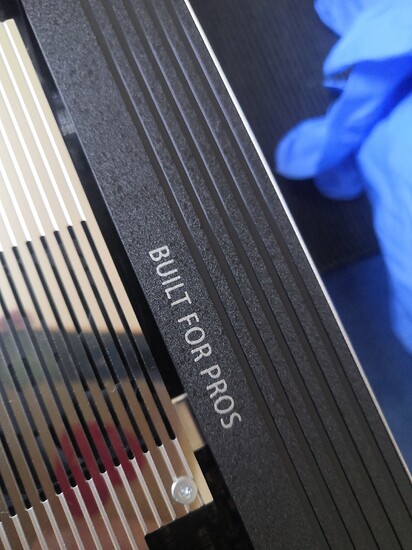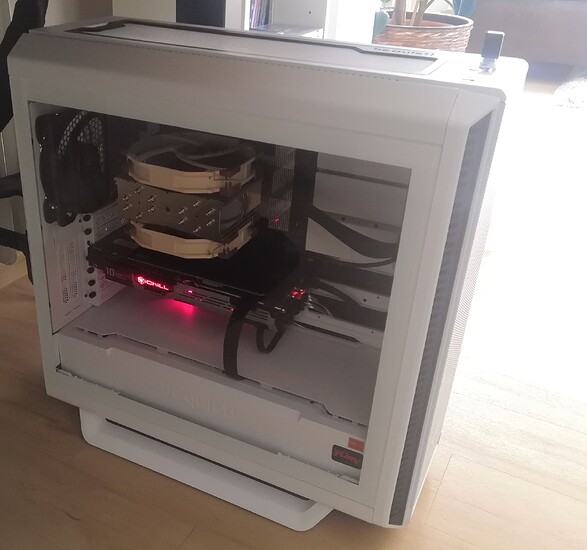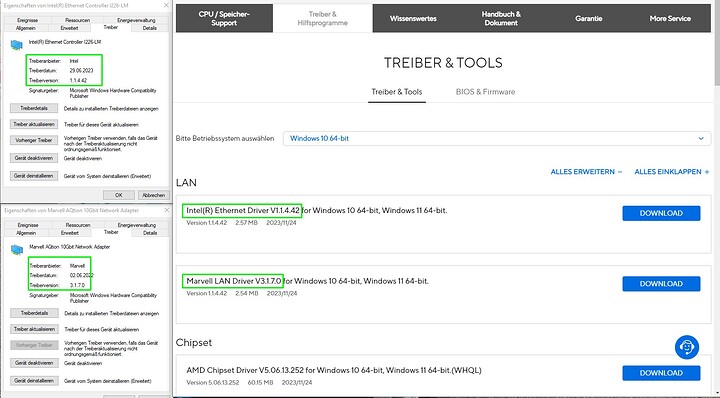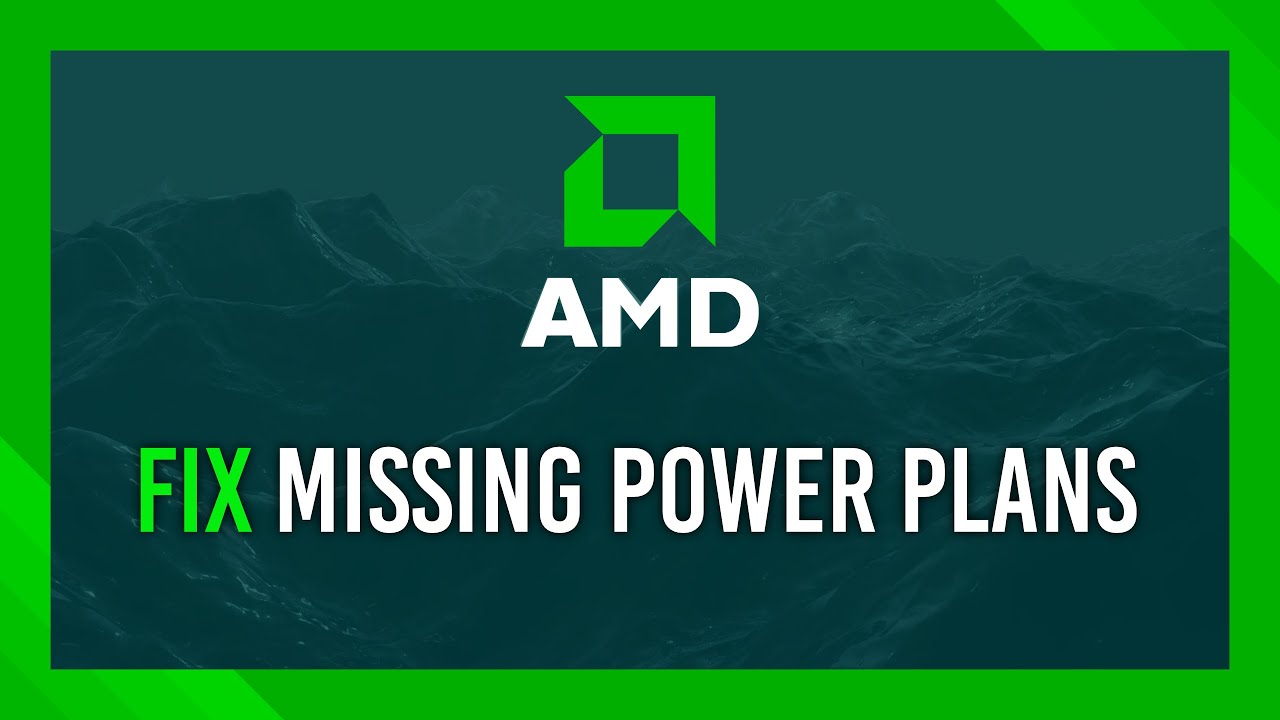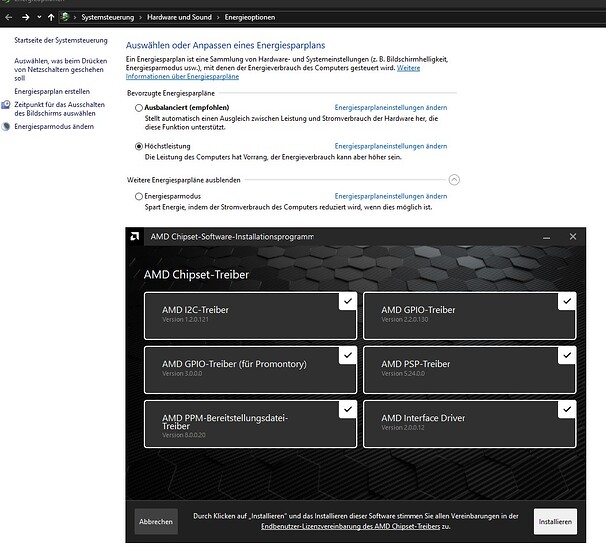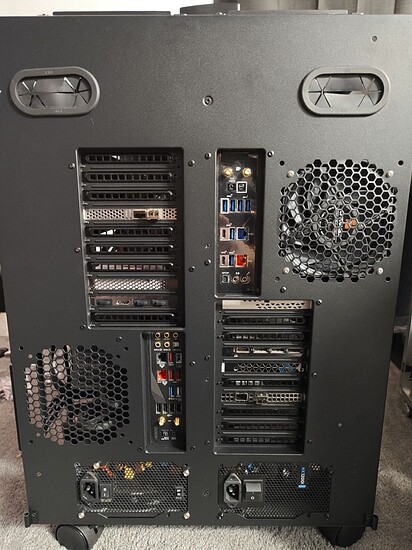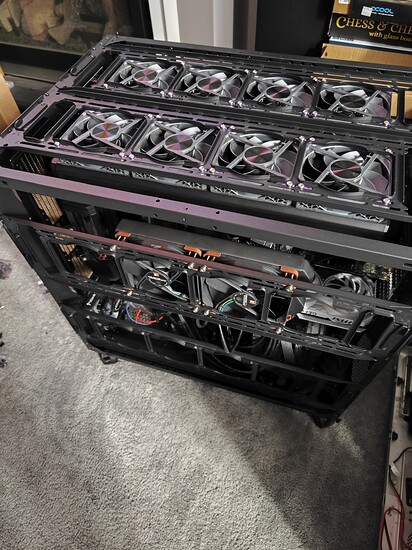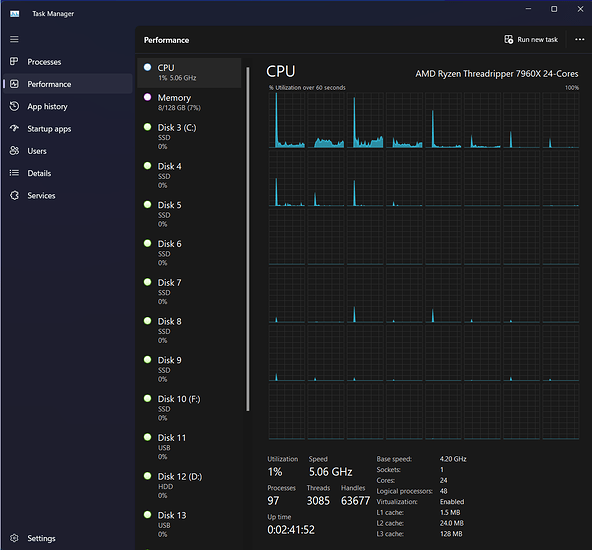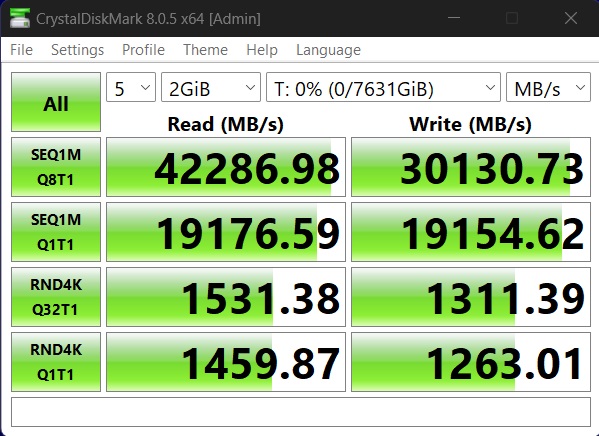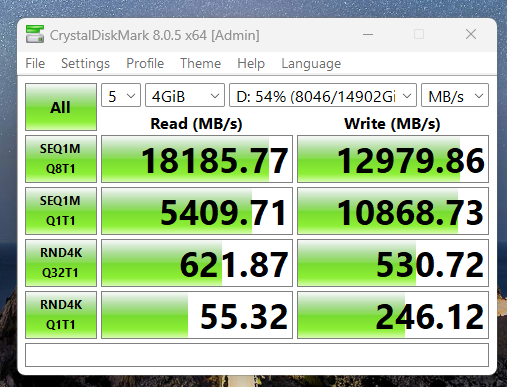My build has been up and running for about a week.
- Motherboard: ASUS WRX90e-SAGE SE
- Processor: 7985WX
- Memory: Kingston KF560R32RBK8-256 (chosen before it was added to the QVL)
- Cooler: Arctic Freezer 4U-M
- PSU: Corsair AX-1600i
- Custom cables: No
- GPU: MSI GeForce GTX 1080
- Add-in cards: Fenvi AX210 M.2 wireless adapter (for the bluetooth)
- Q-codes: None
- Issues/logs: See below…
- Anything else: No overclocking, no XMP profiles. I’m not touching any of those settings until I’m 1000% certain I won’t need an RMA.
Issue #1 - Memory temperature (resolved)
One of my more memory-intensive workloads was causing DIMM temperatures (especially slots B+C and F+G) to rapidly approach 85C+. I added two 40x10mm fans to each bank of DIMMs to get some airflow between the modules. Memory temperatures are now stable at about 70C under prolonged load.
Issue #2 - DisplayPort output doesn’t always work (intermittent)
I initially thought my build was DOA, because I had no signal on my display. Absent any integrated graphics, the remote KVM in the IPMI was a lifesaver. After some troubleshooting, I found that as long as I booted using HDMI, the display would work (even if I switched to the DisplayPort cable after the OS loaded.) Applying this firmware update for my graphics card helped. DisplayPort now works on boot most of the time, but it’s still hit-or-miss.
Issue #3 - Two unexplained freezes in Linux (resolved)
Solution: Set “Global C-state Control” to Disabled in BIOS.
This didn’t happen until today. In both instances, the system was idle when it just stopped responding. The screensaver had the display in powersave mode and it didn’t respond to keypresses. The network stack was dead; no response to my pings. No Q-codes (just the usual “AA”). I could log into the IPMI web interface over the dedicated management network interface, but everything looked normal there (no errors logged, sensors were nominal.) The KVM was “No Signal”, but that’s expected behavior when the OS is displaying via the discrete graphics card.
There was nothing useful in the Linux syslog for the first occurrence, other than a block of NUL characters.
2024-02-24T10:42:49.848854-05:00 mighty /usr/libexec/gdm-x-session[5205]: (II) UnloadModule: "libinput"
2024-02-24T10:42:49.848881-05:00 mighty /usr/libexec/gdm-x-session[5205]: (II) systemd-logind: releasing fd for 13:83
2024-02-24T10:52:10.180297-05:00 mighty ubuntu-report[5069]: level=error msg="data were not delivered successfully to metrics server, retrying in 1800s"
^@^@^@^@^@^@^@^@...a bunch more NUL characters, followed by logs from after I rebooted...^@^@^@^@^@^@^@^@
2024-02-24T12:02:13.292799-05:00 mighty systemd-modules-load[2546]: Inserted module 'lp'
2024-02-24T12:02:13.292867-05:00 mighty systemd-modules-load[2546]: Inserted module 'ppdev'
The second time it happened, there were more interesting messages in the logs, but I’m not sure what it means:
2024-02-24T12:46:07.692777-05:00 mighty systemd[1]: Finished systemd-tmpfiles-clean.service - Cleanup of Temporary Directories.
2024-02-24T12:46:07.696316-05:00 mighty systemd[1]: run-credentials-systemd\x2dtmpfiles\x2dclean.service.mount: Deactivated successfully.
2024-02-24T13:02:06.545553-05:00 mighty rtkit-daemon[4098]: The canary thread is apparently starving. Taking action.
2024-02-24T13:02:06.548921-05:00 mighty rtkit-daemon[4098]: Demoting known real-time threads.
2024-02-24T13:02:06.548958-05:00 mighty rtkit-daemon[4098]: Successfully demoted thread 4101 of process 4062.
2024-02-24T13:02:06.548985-05:00 mighty rtkit-daemon[4098]: Successfully demoted thread 4062 of process 4062.
2024-02-24T13:02:06.549017-05:00 mighty rtkit-daemon[4098]: Successfully demoted thread 4099 of process 4066.
2024-02-24T13:02:06.549041-05:00 mighty rtkit-daemon[4098]: Successfully demoted thread 4066 of process 4066.
2024-02-24T13:02:06.549065-05:00 mighty rtkit-daemon[4098]: Successfully demoted thread 4102 of process 4067.
2024-02-24T13:02:06.549089-05:00 mighty rtkit-daemon[4098]: Successfully demoted thread 4067 of process 4067.
2024-02-24T13:02:06.549116-05:00 mighty rtkit-daemon[4098]: Successfully demoted thread 4097 of process 4063.
2024-02-24T13:02:06.549140-05:00 mighty rtkit-daemon[4098]: Demoted 7 threads.
2024-02-24T13:05:04.031212-05:00 mighty kernel: [ 2047.558967] clocksource: timekeeping watchdog on CPU104: Marking clocksource 'tsc' as unstable because the skew is too large:
2024-02-24T13:05:04.031501-05:00 mighty kernel: [ 2047.559118] clocksource: 'hpet' wd_nsec: 0 wd_now: d32ccbb0 wd_last: 3bbc23fa mask: ffffffff
2024-02-24T13:05:04.031559-05:00 mighty kernel: [ 2047.559195] clocksource: 'tsc' cs_nsec: 177448917847 cs_now: 63eef73df80 cs_last: 5baec91fda0 mask: ffffffffffffffff
2024-02-24T13:05:04.031584-05:00 mighty kernel: [ 2047.559275] clocksource: Clocksource 'tsc' skewed 177448917847 ns (177448 ms) over watchdog 'hpet' interval of 0 ns (0 ms)
2024-02-24T13:05:04.031599-05:00 mighty kernel: [ 2047.559351] clocksource: 'tsc' is current clocksource.
2024-02-24T13:05:04.031615-05:00 mighty kernel: [ 2047.559505] tsc: Marking TSC unstable due to clocksource watchdog
2024-02-24T13:05:04.031635-05:00 mighty kernel: [ 2047.560191] TSC found unstable after boot, most likely due to broken BIOS. Use 'tsc=unstable'.
2024-02-24T13:05:04.031646-05:00 mighty kernel: [ 2047.560246] sched_clock: Marking unstable (2047570944386, -9984456)<-(2047606829910, -46893244)
2024-02-24T13:05:04.054823-05:00 mighty kernel: [ 2047.566605] clocksource: Checking clocksource tsc synchronization from CPU 23 to CPUs 0,3,36,43-44,60,67,118.
2024-02-24T13:05:04.055208-05:00 mighty kernel: [ 2047.587010] clocksource: Switched to clocksource hpet
2024-02-24T13:05:04.073177-05:00 mighty systemd[1]: systemd-logind.service: Watchdog timeout (limit 3min)!
2024-02-24T13:05:04.082146-05:00 mighty rtkit-daemon[4098]: The canary thread is apparently starving. Taking action.
2024-02-24T13:05:04.083693-05:00 mighty systemd[1]: systemd-logind.service: Killing process 3657 (systemd-logind) with signal SIGABRT.
2024-02-24T13:05:04.084653-05:00 mighty rtkit-daemon[4098]: Demoting known real-time threads.
2024-02-24T13:05:04.085463-05:00 mighty rtkit-daemon[4098]: Successfully demoted thread 4101 of process 4062.
2024-02-24T13:05:04.086488-05:00 mighty rtkit-daemon[4098]: Successfully demoted thread 4062 of process 4062.
2024-02-24T13:05:04.087332-05:00 mighty rtkit-daemon[4098]: Successfully demoted thread 4099 of process 4066.
2024-02-24T13:05:04.088061-05:00 mighty rtkit-daemon[4098]: Successfully demoted thread 4066 of process 4066.
2024-02-24T13:05:04.088843-05:00 mighty rtkit-daemon[4098]: Successfully demoted thread 4102 of process 4067.
2024-02-24T13:05:04.089553-05:00 mighty rtkit-daemon[4098]: Successfully demoted thread 4067 of process 4067.
2024-02-24T13:05:04.090417-05:00 mighty rtkit-daemon[4098]: Successfully demoted thread 4097 of process 4063.
2024-02-24T13:05:04.091255-05:00 mighty rtkit-daemon[4098]: Demoted 7 threads.
(No more logs until I noticed it was unresponsive and rebooted the system...)
2024-02-24T15:00:53.061061-05:00 mighty systemd-modules-load[2361]: Inserted module 'lp'
I spent some time today setting up serial console through the IPMI, so if this happens again, more troubleshooting options might be available.
